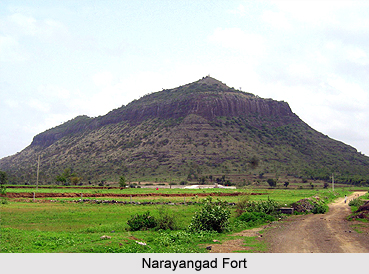 Narayangad Fort is a hill fort which is located on a detached hill near Narayangaon town in the district of Pune in the state of Maharashtra, India. The site is almost 3 miles towards the east of the town of Narayangoan. It is at a distance of 5 km from Khodad village, 8 km from Narayangaon and 80 km from Pune. The fortress was built during the Satavahana period and was mainly utilised as a watch tower for the Junnar Paithan route.
Narayangad Fort is a hill fort which is located on a detached hill near Narayangaon town in the district of Pune in the state of Maharashtra, India. The site is almost 3 miles towards the east of the town of Narayangoan. It is at a distance of 5 km from Khodad village, 8 km from Narayangaon and 80 km from Pune. The fortress was built during the Satavahana period and was mainly utilised as a watch tower for the Junnar Paithan route.
History of Narayangad Fort
Narayangad Fort was founded by the first Peshwa Balaji Vishwanath. It was given to Sayaji Povar as service grant. After the Anglo Maratha War of 1818, the fort at Narayangad was occupied by the army of British East India Company.
Architecture of Narayangad Fort
The structure is built on the north south direction of the hill and the primary gateway of the fortress is located on the western direction. There are two water reservoirs above the fort named Chambar Take and Narayan Take. Moreover there is a temple devoted to Goddess Hastamata to the top of Narayangad Fort. There is a Mukaai temple towards the base of the hill. There are some other ruins located on the hill such as a stone doorway which includes a lintel of a figure of Lord Ganesha and 2 attendant tigers.
Present Condition of Narayangad Fort
Presently, the site is under the maintenance of the Government of India. The Narayangad Fort is now open to tourists and visitors throughout the year. It is also a popular destination for trekkers.
This article is a stub. You can enrich by adding more information to it. Send your Write Up to content@indianetzone.com



















